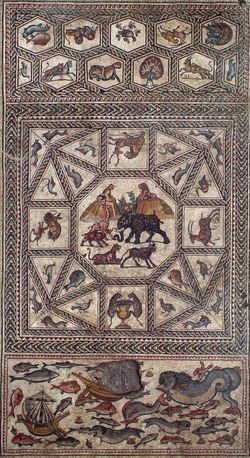(מכון ישראלי לארכיאולוגיה (ע"ר
Israeli Institute of Archaeology
The Roman and Byzantine Periods (37 BCE-640 CE)
Excavations within the city revealed magnificent Roman villas containing mosaics, marble furniture, gold coins and jewelry. The crowning glory of these findings is the most impressive mosaic floor ever found in Israel and one of the most impressive worldwide, discovered in 1996 in the remains of a roman villa dated to the 4th century CE. The mosaic features ships and sea images which might suggest the owner was a seafarer.
St. George was born and raised in Lod. He later became an officer in the Guard of the emperor Diocletian, and chose to spread Christianity throughout the world at a time when it was forbidden, especially to those serving the Roman army. Many legends recount that in one of his journeys George encountered a fearsome dragon, which he fought and conquered. The scene of the battle between St. George and the dragon became one of the most important scenes depicted in Christian Art worldwide.
As a result of his missionary work, St. George was executed by the Army authorities, and became a martyr. When Christianity was officially recognized years later, his bones were brought to burial in a subterranean crypt at the Greek Orthodox church in Lod.
During the Byzantine period, the city's name was changed to Georgeopolis, the city of George, and several magnificent churches were built.
During the Mishnah period Lod housed one of the important Jewish centers of spiritual and literary studies. Many of the known Rabbis of the period lived and were active in Lod, from the destruction of Jerusalem in 70 CE and up to the Bar-Kokhba Revolt in 132 CE.
The famous Rabban Gamliel was active in Lod and only later moved to Yavne. Rabbi Eliezer ben Horcanos (Known for the phrase “Justice, justice shall you pursue”) was the first sage identified with Lod, and Rabbi Aqiva was one of his most prominent students. Rabbi Joshua, another important teacher, moved from the Galilee to Lod and founded a seminary. Rabbi Judah, although affiliated with Zippori, used to visit Lod and was active in it. The sages of Lod were part of the local life, and with their pupils they roamed the streets, markets, and roads, learning, discussing, and litigating.
 |  |
|---|---|
 |  |
 |  |
 |  |
 |  |
 |  |
 |  |